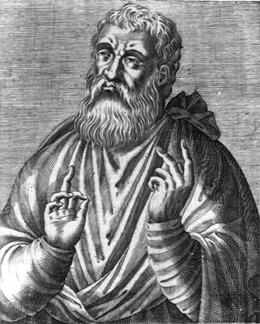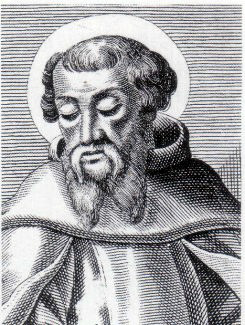 I skipped a few chapters in T. F. Torrance's Divine Meaning to the chapter "Early Patristic Interpretation of the Scriptures", though I've since promised my advisor that I will go back and read the earlier chapters. This is a long (perhaps longer than it needed to be) essay tracing the development of a scientific exegesis of scripture from Justin Martyr through Melito of Sardis to Irenaeus. The meat of it is that because the Gnostics could justify any teaching they wanted by appealing to scripture through the use of sloppy interpretation (eisegesis), these early Church Fathers perceived the need to develop ways of interpreting scripture that arose from the nature of scripture itself so that the pure proclamation of Jesus Christ, the kerygma, could be preserved from heresy.
I skipped a few chapters in T. F. Torrance's Divine Meaning to the chapter "Early Patristic Interpretation of the Scriptures", though I've since promised my advisor that I will go back and read the earlier chapters. This is a long (perhaps longer than it needed to be) essay tracing the development of a scientific exegesis of scripture from Justin Martyr through Melito of Sardis to Irenaeus. The meat of it is that because the Gnostics could justify any teaching they wanted by appealing to scripture through the use of sloppy interpretation (eisegesis), these early Church Fathers perceived the need to develop ways of interpreting scripture that arose from the nature of scripture itself so that the pure proclamation of Jesus Christ, the kerygma, could be preserved from heresy.One point of note is Torrance's interest in distinguishing typological interpretation of Old Testament passages as fulfilled in the history of Jesus Christ, a practice Torrance cautiously affirms, and allegorical interpretation of passages from the Old and New Testaments depicting ostensibly historical events as finding their real meaning in timeless esoteric truths, a practice
 Torrance vehemently denounces as rooted in Platonic dualism between the sensible and intelligible, aka the boogie monster.
Torrance vehemently denounces as rooted in Platonic dualism between the sensible and intelligible, aka the boogie monster.The practical difference seems to be that allegory can get you anywhere, while typology always points you to Christ; allegory has the potential to break up the Truth of the gospel into truths, or even to break reality into, yes Torrance, a dualism between the sensible and intelligible, while typology holds together all of scripture in the one truth of Jesus Christ. Torrance puts it this way:
This typological way of interpreting the Old Testament seems to be finding renewed popularity. I myself find it helpful and edifying. Torrance seems to as well, but he also sees how easily it slid into allegorical readings that enabled the Gnostics. This necessitated a stronger framework within which to interpret scripture that would not be so prone to fanciful perversions.Typology of this kind, which must not be confused with allegory, was an important part of early Church exegesis, for it was a reflection of the deep connections between the Christian Gospel and the ancient past, and an important tool in its battle against gnostic and Marcionite attempts to cut it away from its historical sources and its ground in the fulfillment in space and time of God's creative and redemptive acts. Patristic typology had its roots in Palestinian Judaism. It had its significance within the inseparable relation of word and event and the dramatic images that it involved, and it arose through the use of cultic patterns to point ahead to the enactment and fulfilment in decisive events within the history of the covenant people of God. It was the fulfilment of the ancient promises and figures in the birth and life and death of Jesus Christ that brought it into prominence in early Christianity, for with that fulfilment it was possible to interpret the history of Israel as the pre-history of the Incarnation, and to see how the patterns of Israel's life, manifested in the great events of its history and reflected in the cult, partially realised in the ordeal of suffering, and interpreted by the prophets, all converged in the fact of Christ. Such interpretation of the Old Testament which set forth an account of the acts of God in the old and new economies of Israel and the Incarnation as the fulfilment of the one saving purpose became essential from the start of the Church's life, for it not only assimilated the Old Testament revelation with the New Testament revelation but preserved the unity of the doctrine of God.
 This he finds in Irenaeus, in whose hermeneutics Torrance detects three active principles at work. First is the rule of truth, which seems similar to the Reformers' doctrine of the perspicuity of scripture, though Irenaeus ties it to the perspicuity of reality and God's purposes for all of reality in the Gospel. The driving idea here is that though there are parables and other passages of scripture in which the meaning might not be immediately clear, the historical reality of what God has done through Israel and supremely in Christ, to which all of scripture points, is abundantly clear. This clarity lays an obligation on the interpreter of the Bible to interpret it in all its parts according to that clear historical truth.
This he finds in Irenaeus, in whose hermeneutics Torrance detects three active principles at work. First is the rule of truth, which seems similar to the Reformers' doctrine of the perspicuity of scripture, though Irenaeus ties it to the perspicuity of reality and God's purposes for all of reality in the Gospel. The driving idea here is that though there are parables and other passages of scripture in which the meaning might not be immediately clear, the historical reality of what God has done through Israel and supremely in Christ, to which all of scripture points, is abundantly clear. This clarity lays an obligation on the interpreter of the Bible to interpret it in all its parts according to that clear historical truth.
No comments:
Post a Comment